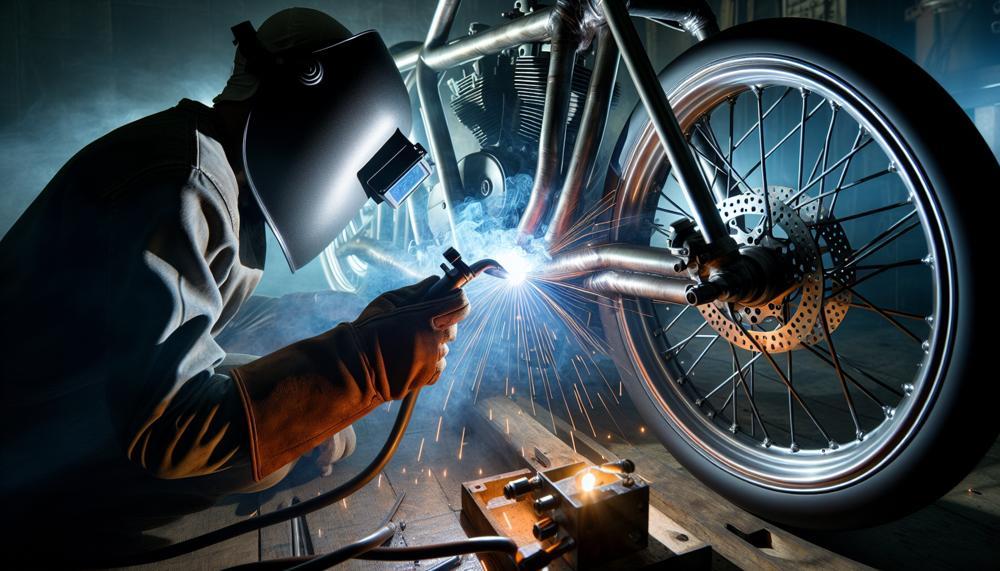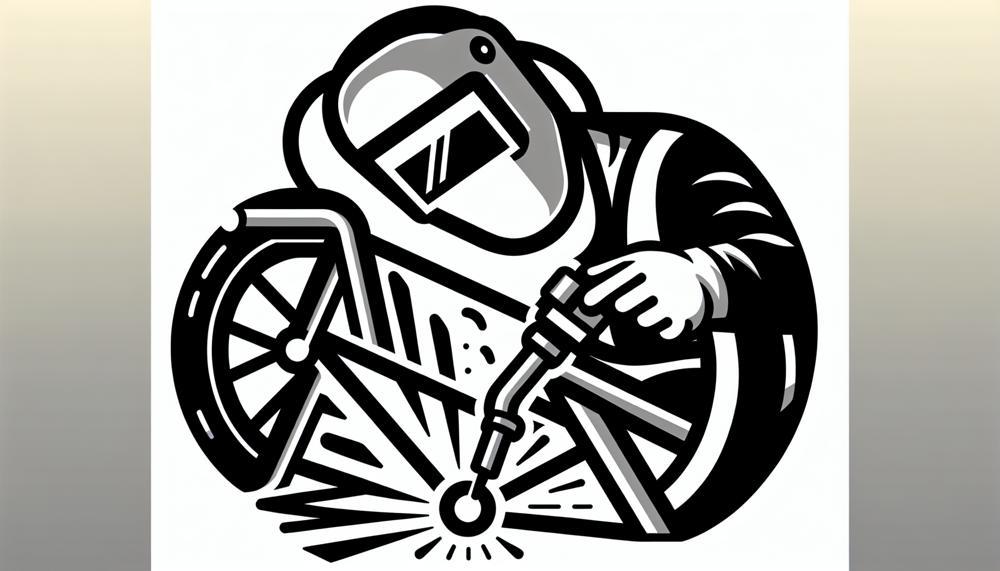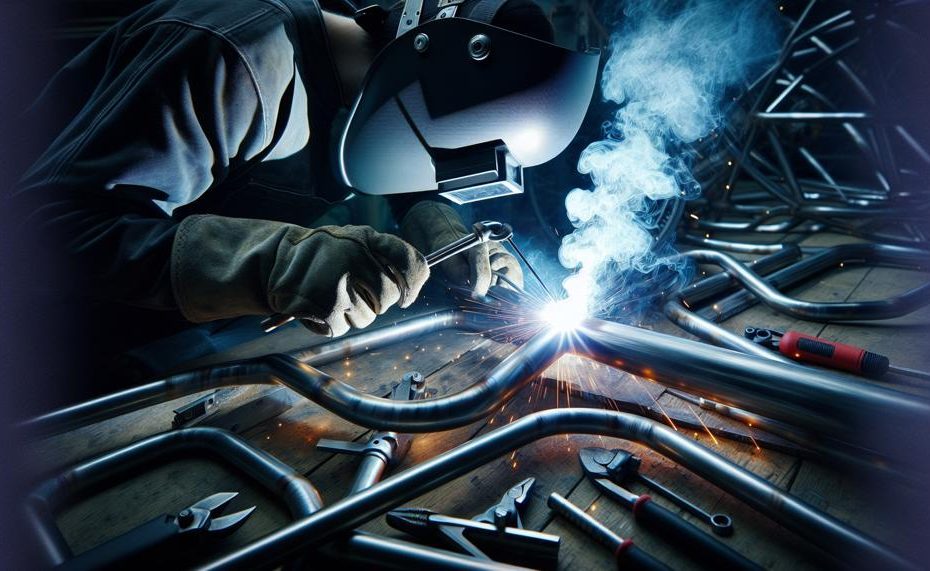As a motorcycle enthusiast, you understand the importance of a strong and sturdy frame. After all, it’s the backbone of your bike and plays a vital role in its performance and safety. So when it comes to welding your motorcycle frame, you want to make sure you’re using the best method for the job. And that’s where the age-old debate of tig vs mig welding comes into play.
But before we dive into the nitty-gritty details, let’s first understand what each method entails. Tig (Tungsten Inert Gas) welding involves using a non-consumable tungsten electrode to create precise and clean welds.

On the other hand, Mig (Metal Inert Gas) welding uses a consumable wire electrode and an inert gas to protect the weld from oxidation.
Now, let’s address the elephant in the room – which one is better for motorcycle frames? Well, that depends on several factors such as strength, appearance, ease of use, and most importantly, personal preference.
While tig welding is known for its precision and neat finish, mig welding is praised for its speed and ease of use. However, when it comes to strength and durability, both methods have their pros and cons depending on the type of metal being welded.
So, how do you decide between tig or mig welding for your motorcycle frame? That’s where our comprehensive breakdown of each method comes in. We’ll explore their strengths and weaknesses to help you make an informed decision based on your skill level and specific project needs.
So, buckle up as we take a deep dive into this never-ending debate of tig vs mig welding for motorcycle frames.
Contents
- 1 What Welding Technique Is Best for Motorcycle Frame?
- 2 Is Tig Or Mig Better For Motorcycle Frames?
- 3 Can You Stick Weld A Motorcycle Frame?
- 4 What Are the Tools and Things You Need before Motorcycle Frame Welding?
- 5 How Do You Stick Weld a Motorcycle Frame: Step-by-Step Guide
- 6 Motorcycle Frame Welding Common Mistakes and How to Avoid Them?
- 7 Conclusion
What Welding Technique Is Best for Motorcycle Frame?
TIG (Tungsten Inert Gas) and MIG (Metal Inert Gas) welding are two popular welding techniques used for joining metal materials. Both methods use electricity to create an arc that melts the metal, allowing it to fuse together. This process requires a great deal of skill and expertise, making it a top choice for experienced welders.
There are some key differences between TIG and MIG welding:
| TIG Welding | MIG Welding |
| Utilizes a tungsten electrode to create an arc that melts the metal. | Uses a continuous wire electrode as a filler material. |
| Requires the use of two hands – one for holding the torch and one for feeding the filler rod. | Can be operated with only one hand as the wire feed is automatic. |
| Ideal for precision and clean finishes, making it well-suited for intricate designs. | Faster and more efficient for larger and thicker pieces of metal. |
| Offers better control over heat input, resulting in less distortion and higher quality welds. | Produces faster welding speeds but can result in more distortion and spatter. |
| A slower process compared to MIG welding, but can be done by hand or with a machine. | A faster process that requires a machine operator to do all the work. |
| Generally better for thinner materials, such as DOM steel tubing used in motorcycle frames. | Suitable for thicker materials, such as steel plates or thicker tubing. |
Which welding technique is best for motorcycle frames?
When it comes to welding motorcycle frames, determining the best technique depends on the specific project requirements and the welder’s expertise. However, for welding motorcycle frames, TIG welding is widely considered the superior option.
This is largely due to the fact that motorcycle frames are typically constructed using thin DOM steel tubing, which requires precision and control during the welding process. Fortunately, TIG welding is well-known for its precision and clean finish, making it an ideal choice for intricate designs and thinner materials like DOM steel tubing.
Moreover, TIG welding produces less distortion and higher quality welds compared to MIG welding, which is crucial for maintaining the structural integrity of a motorcycle frame. It also offers better control over heat input, resulting in a stronger and more durable weld.
While MIG welding may be faster and more efficient, it can also lead to more distortion and spatter, which can be challenging to clean up and may affect the overall appearance of the motorcycle frame.
Is Tig Or Mig Better For Motorcycle Frames?
TIG (Tungsten Inert Gas) and MIG (Metal Inert Gas) welding are two commonly employed techniques for crafting motorcycle frames. Both methods offer distinct advantages and disadvantages, and the optimal choice hinges upon specific factors.
TIG Welding: Precision and Strength
TIG welding stands out for its meticulousness and robust welds. It entails utilizing a non-consumable tungsten electrode to generate an arc that melts the metal, while a shielding gas averts contamination. This technique allows for precise control over the weld pool, enabling intricate welds and the joining of dissimilar metals.
Moreover, TIG welds tend to be stronger and more durable than their MIG counterparts, making them an excellent option for constructing motorcycle frames that demand utmost strength and reliability.
MIG Welding: Efficiency and Simplicity
MIG welding, in contrast, prioritizes efficiency and user-friendliness. It employs a continuously fed consumable electrode that melts and fuses with the base metal, shielded by an inert gas.
This method is renowned for its rapid welding speed and relative ease of use, making it suitable for large-scale production environments.
While MIG welds may not possess the same level of strength and precision as TIG welds, they still offer satisfactory performance for many motorcycle frame applications.
Comparative Table: TIG vs. MIG Welding
| Feature | TIG Welding | MIG Welding |
| Weld Strength | Superior | Satisfactory |
| Weld Precision | Excellent | Good |
| Weld Appearance | Clean and Refined | Slightly Less Refined |
| Welding Spee | Slower | Faster |
| Ease of Use | Requires Skilled Welder | Less Skilled Welder Required |
| Cost | Generally Higher | Generally Lower |
| Suitability for Motorcycle Frames | Ideal for High-Performance Frames | Suitable for Production Frames |
Can You Stick Weld A Motorcycle Frame?
Stick welding, also known as Shielded Metal Arc Welding (SMAW), is a welding method that uses a stick as the electrode. The welding machine includes an electrode holder and a stick with a wire core and flux coating. When struck against the base metal, the electrode forms an arc that melts the wire and creates filler metal while the flux produces shield gas.
Stick welding is relatively easy to set up and learn, but mastering its subtleties can be challenging. However, it is highly versatile and can be used for various joint types and metal types, including rusted or damaged base metals.
On the other hand, TIG welding utilizes a tungsten electrode to create an arc that melts the base metal and filler rod, resulting in precise and clean welds. It is ideal for delicate or thinner motorcycle frames due to better control of heat input, and it also produces minimal spatter, making it easier to maintain a clean finish.
However, when considering stick welding on a motorcycle frame, there are several pros and cons compared to TIG or MIG welding. Stick welding can be cost-effective as it does not require an external gas supply like TIG or MIG welding.
It also produces strong and penetrating welds perfect for durable motorcycle frames. Additionally, stick welding is versatile and can be used on various types of metals commonly found in motorcycle frames.
On the other hand, stick welding requires skill and experience to master compared to TIG or MIG welding. If not cleaned thoroughly beforehand, it may produce spatter and weaken the weld. The amperage and heat must be precisely adjusted to avoid damaging the frame’s surface.
Stick welding may not be suitable for thinner or delicate motorcycle frames as controlling heat input can be more challenging than TIG welding.
What Are the Tools and Things You Need before Motorcycle Frame Welding?
When it comes to welding a motorcycle frame, the specific equipment and materials you need will depend on the chosen method. But regardless of which method you choose, there are some common tools and things that you’ll require.
For TIG welding, you’ll need a TIG welder, which is different from a MIG welder. Along with the welder, you’ll also need a TIG torch, tungsten electrode, filler rod, argon gas, and a flowmeter or regulator. On the other hand, for MIG welding, you’ll need a MIG welder, wire feeder, shielding gas (which is usually a mixture of argon and carbon dioxide), and welding wire.
Both methods also require proper safety gear such as gloves, helmets, and protective clothing to protect against sparks and UV radiation. These are necessary precautions that should never be overlooked.

| Equipment/Tool | TIG Welding | MIG Welding |
| TIG Welder | Necessary | Not Required |
| TIG Torch | Necessary | Not Required |
| Tungsten Electrode | Necessary | Not Required |
| Filler Rod | Necessary | Not Required |
| Argon Gas | Necessary | Not Required (unless using a MIG/TIG combo welder) |
| Flowmeter/Regulator | Necessary | Not Required (unless using a separate gas cylinder) |
| MIG Welder | Not Required | Necessary |
| Wire Feeder | Not Required | Necessary |
| Shielding Gas | Not Required (unless using a TIG/MIG combo welder) | Necessary (typically a mix of argon and CO2) |
How Do You Stick Weld a Motorcycle Frame: Step-by-Step Guide
When venturing into any welding project, especially stick welding on a motorcycle frame, it is crucial to take proper safety measures. This not only guarantees the safety of yourself but also those around you.
- Wear Appropriate Clothing: It is vital to dress appropriately before starting any welding project. This includes wearing long-sleeved shirts, long pants, leather welding gloves, and closed-toe shoes. Additionally, a welding helmet with a dark tinted lens should be worn for eye protection against the intense light.
- Clear the Work Area: Ensure that the work area is free from any flammable materials like gasoline or oil. This prevents potential fires and keeps you safe while working.
- Prepare the Material: Before starting the welding process, it is important to prepare the material for welding. This involves cleaning off any dirt, rust, or paint from the surface to ensure a strong bond.
- Proper Grounding: Proper grounding of the electrical current is essential during stick welding to prevent electric shocks and ensure safety for yourself and others in the area. Make sure that the ground clamp is securely attached to the workpiece.
- Practice on Scrap Pieces: Stick welding requires practice to master, so it is recommended to practice on scrap pieces of metal before attempting an actual repair job on a motorcycle frame.
Motorcycle Frame Welding Common Mistakes and How to Avoid Them?
| Failing to properly clean the surface | Prior to welding, it is critical to thoroughly clean the frame’s surface using a wire brush and paper towels to eliminate any traces of oil or grease. |
| Using incorrect heat settings | It is important to adjust the amps according to the chosen electrode diameter, with medium heat being ideal to prevent damage to the frame’s surface. |
| Misplacing the arc strike point | Always strike the arc at the correct spot rather than outside of it in order to avoid damaging the frame’s surface. |
| Using additional gases for stick welding | Stick welders do not require additional gases for welding motorcycle frames as they produce their own shielding gas. Using additional gases can result in excessive spatter. |
| Not allowing joints to cool before handling them | After completing all joints, it is crucial to allow them to cool before touching them with bare hands in order to prevent cracking or damaging the frame’s surface. |
| Inadequate grip on the welder and using only one hand | To maintain control while stick welding, use both hands and carefully follow each step. |
In addition to these common mistakes, it is essential to always wear proper safety equipment and practice on scrap pieces before attempting the actual project. It is also important to have all necessary tools, such as a high-quality stick welder, suitable electrodes, ground clamp, and electrode holder.
Moreover, to ensure a successful welding process, it is vital to have a solid understanding of the welding techniques and proper welding positions. Additionally, taking breaks in between welding sessions can prevent overheating and allow for better weld quality.
Paying attention to details and constantly monitoring the welding process can help catch any mistakes early on and prevent them from becoming major issues.
By following these prevention methods and taking necessary precautions, the task of welding a motorcycle frame can be completed efficiently and effectively without any significant errors.
Conclusion
In summary, the debate between tig and mig welding for motorcycle frames is one that has been ongoing for years.
While both methods have their strengths and weaknesses, the ultimate decision depends on factors such as personal preference, skill level, and project requirements. However, after a thorough analysis of each technique and its pros and cons, it can be concluded that TIG welding is widely considered the superior option for motorcycle frames due to its precision, heat control, and clean finish.
Stick welding can also be a viable choice depending on the welder’s expertise and the frame’s type. Regardless of which method is chosen, safety measures must be taken seriously to avoid common mistakes and ensure a successful welding process.





